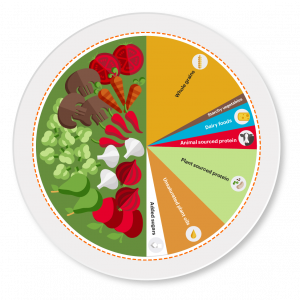Saskia Lichtin
What if there was a diet that could feed the entire global population, while reducing damage to the environment and on top of that, saving millions of lives currently threatened by poor lifestyle choices?

The global population is expected to rise to almost 10 billion people by the year 2050 (United Nations, 2019). With still around 820 million people suffering from hunger today, we must pose the question – how are we going to feed the world? In our current food system, unfortunately, hunger is not the only problem. Around three billion people in the world are estimated to not eating well, leading to micronutrient deficiencies but also, and often simultaneously to obesity (FAO, 2019). In reality, factors such as poor diet and a sedentary lifestyle account for over 11 million deaths per year (GBD, 2019). The expected shift towards Western eating habits by emerging and developing countries raises the concern whether coming out of starvation will just lead to the other, equally as destructive extreme. So, the real question shouldn’t be if we can feed everybody at all, but if there is a way to feed the world that entails a nutritionally adequate diet while also limiting damage to the environment.
An international team of 37 experts set themselves the objective to find answers to this very question. The group is called the EAT-Lancet Commission, they’re a global non-profit foundation, which published their suggestions last year: The Planetary Health Diet. The scientists found that healthy diets are plant-focused, meaning that most of the plate needs to consist of vegetables, fruits, whole grains, plant sourced protein such as nuts and legumes and unsaturated plant oils. The remaining fraction consists of dairy foods, animal sourced protein and added sugars. The report summarises the diet as follows: “This is a flexitarian diet, which is largely plant-based but can optionally include modest amounts of fish, meat and dairy foods.” It is emphasized that the suggestions only outline food groups and ranges of food intakes and do not dictate an exact diet or meal plan. Local interpretation of the guidelines with respect to culture, geography and demography of the population is extremely important (EAT, 2019).

For Europeans, the guidelines seem to demand a rather drastic shift of our eating patterns. Apparently, we eat too much of the products that are bad for the planet and promote disease and too little foods that are nutritious and would have a small carbon footprint (EAT, 2019). On top of that, food waste needs to be halved. The EAT-Lancet Commission tries to make the transition to the planetary health diet as easy as possible. For example, on their website https://eatforum.org/planetary-health-recipes/ they provide a range of simple and delicious recipes.
In conclusion, the shift to a sustainable and health-promoting diet is possible. It will most likely require some getting used to, however, as Carrington (2019) highlights, the transition is a “win-win” situation. While saving the planet with our food choices, at least 11 million lives would be saved as a result of the nutritional benefits of the diet. So, I urge everyone to utilise the information we have at our fingertips to make informed choices about their food intake. Because when talking about the Sustainable Development Goals, there cannot be a discussion without talking about the elephant in the room.
References
Carrington, D. (2019). New plant-focused diet would ‘transform’ planet’s future, say scientists. The Guardian.
EAT. (2019). Food in the Anthropocene: the EAT–Lancet Commission on healthy diets from sustainable food systems. The Lancet.
EAT. (2019). Healthy Diets From Sustainable Food Systems: Summary Report of the EAT-Lancet Commission.
FAO. (2019). The State of Food Security and Nutrition in the World. Rome.
GBD. (2019). Health effects of dietary risks in 195 countries, 1990–2017: a systematic analysis for the Global Burden of Disease Study 2017. The Lancet.
United Nations. (2019, Juni 17). Growing at a slower pace, world population is expected to reach 9.7 billion in 2050 and could peak at nearly 11 billion around 2100. Retrieved from https://www.un.org/development/desa/en/news/population/world-population-prospects-2019.html
Media Attributions
- Getty Images
- EAT-Lancet_PHD_Plate